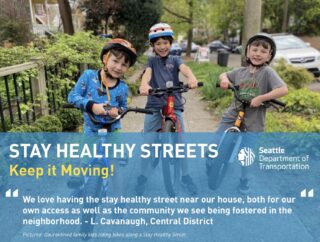
While Portland basks in the glow of finally launching a transportation-related response to the Covid-19 pandemic, Seattle has taken theirs up a notch. The city announced yesterday that 20 miles of their pilot network of traffic-calmed streets with reduced access for drivers will become permanent.
“We are in a marathon and not a sprint in our fight against COVID-19,” said Seattle Mayor Jenny Durkan in a blog post from her department of transportation. “As we assess how to make the changes that have kept us safe and healthy sustainable for the long term, we must ensure Seattle is rebuilding better than before. Stay Healthy Streets are an important tool for families in our neighborhoods to get outside, get some exercise and enjoy the nice weather. Over the long term, these streets will become treasured assets in our neighborhoods.”
“We’re announcing a nimble, creative approach towards rapidly investing in a network of places for people walking and people biking of all ages and abilities.”
— Sam Zimbabwe, Seattle DOT director
Seattle got a big head start on Portland. They launched a “Stay Healthy Streets” initiative on April 17th. On that same day in Portland we reported PBOT Commissioner Chloe Eudaly was “nervous about the consequences” of doing any street-related interventions because of concerns about equity, resource capacity, dangers posed by speeding drivers, and Portland’s lack of density.
Thankfully Eudaly has changed her tuned an announced our “Slow Streets Safe Streets” effort on April 28th. With the first 100 locations set to be fully installed sometime today, it’s unclear what kind of impact the initiative will have.
Advertisement

Meanwhile, Seattle DOT Director Sam Zimbabwe told the Seattle Times their program to keep non-essential drivers off some neighborhood streets has been, “transformative” and that they want to, “continue to build out a transportation system that enables people of all ages and abilities to bike and walk across the city.”
A blog post from Seattle DOT published yesterday (that includes photos of smiling kids and positive quotes from Healthy Streets users) said creating better bike infrastructure is also a “critical” part of their response in part due to expected drops in transit capacity. “Seattle must be able to get around without needing to rely on vehicles,” reads the post. Zimbabwe said, “That is why we’re announcing a nimble, creative approach towards rapidly investing in a network of places for people walking and people biking of all ages and abilities.”
SDOT put added emphasis on a directive from Mayor Durkan to, “Evaluate and accelerate implementation of other bicycle facilities.” “We’re taking a serious look at advancing key projects or filling gaps in the bike network to make it easier for people to ride bikes.” she said.
Portland advocates with Bike Loud PDX have called for faster implementation of existing and adopted bikeway projects — like those in the Central City in Motion plan.
Asked at a press event yesterday how long Portland’s temporary “Local Access Only” signs and barricades would be up, PBOT Communications Director said, “For the foreseeable future.”
PBOT staff have hinted that some locations are likely to be “hardened” (made permanent) to keep greenways from being overrun by drivers as physical distancing requirements soften. That move won’t come until “Phase 2.5” of their current plans which is defined as being after the Governor’s “Stay Home” order is lifted (likely to be May 15th) and before we begin to “Reinvest, Recover, Rebuild”.
— Jonathan Maus: (503) 706-8804, @jonathan_maus on Twitter and jonathan@bikeportland.org
— Get our headlines delivered to your inbox.
— Support this independent community media outlet with a one-time contribution or monthly subscription.

